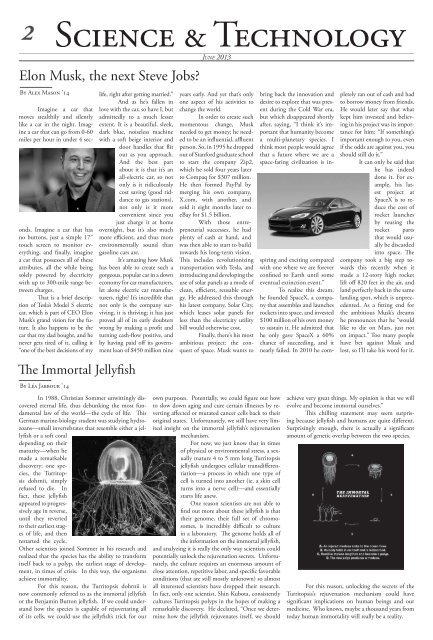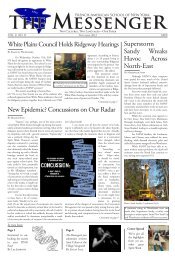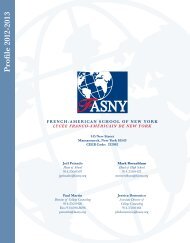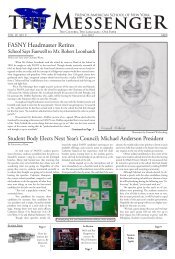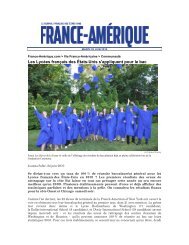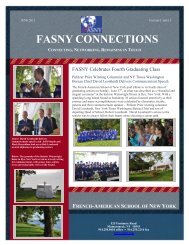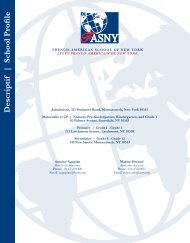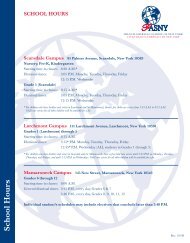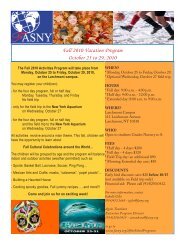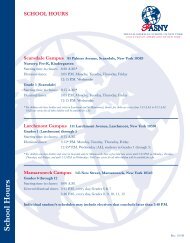Students Solve - Franco-American School of New York
Students Solve - Franco-American School of New York
Students Solve - Franco-American School of New York
- No tags were found...
Create successful ePaper yourself
Turn your PDF publications into a flip-book with our unique Google optimized e-Paper software.
2Science & TechnologyElon Musk, the next Steve Jobs?By Alex Mason ’14Imagine a car thatmoves stealthily and silentlylike a cat in the night. Imaginea car that can go from 0-60miles per hour in under 4 seconds.Imagine a car that hasno buttons, just a simple 17”touch screen to monitor everything,and finally, imaginea car that possesses all <strong>of</strong> theseattributes, all the while beingsolely powered by electricitywith up to 300-mile range betweencharges.That is a brief description<strong>of</strong> Tesla’s Model S electriccar, which is part <strong>of</strong> CEO ElonMusk’s grand vision for the future.It also happens to be thecar that my dad bought, and henever gets tired <strong>of</strong> it, calling it“one <strong>of</strong> the best decisions <strong>of</strong> myThe Immortal JellyfishBy Léa Jabbour ’14life, right after getting married.”And as he’s fallen inlove with the car, so have I, butadmittedly to a much lesserextent. It is a beautiful, sleek,dark blue, noiseless machinewith a s<strong>of</strong>t beige interior anddoor handles that flitout as you approach.And the best partabout it is that it’s anall-electric car, so notonly is it ridiculouslycost saving (good riddanceto gas stations),not only is it moreconvenient since youjust charge it at homeovernight, but it’s also muchmore efficient, and thus moreenvironmentally sound thangasoline cars are.It’s amazing how Muskhas been able to create such agorgeous, popular car in a downeconomy for car manufacturers,let alone electric car manufacturers,right? It’s incredible thatnot only is the company surviving,it is thriving; it has justproved all <strong>of</strong> its early doubterswrong by making a pr<strong>of</strong>it andturning cash-flow positive, andby having paid <strong>of</strong>f its governmentloan <strong>of</strong> $450 million nineJu n e 2013years early. And yet that’s onlyone aspect <strong>of</strong> his activities tochange the world.In order to create suchmomentous change, Muskneeded to get money; he neededto be an influential, affluentperson. So, in 1995 he droppedout <strong>of</strong> Stanford graduate schoolto start the company Zip2,which he sold four years laterto Compaq for $307 million.He then formed PayPal bymerging his own company,X.com, with another, andsold it eight months later toeBay for $1.5 billion.With those entrepreneurialsuccesses, he hadplenty <strong>of</strong> cash at hand, andwas then able to start to buildtowards his long-term vision.This includes revolutionizingtransportation with Tesla, andintroducing and developing theuse <strong>of</strong> solar panels as a mode <strong>of</strong>clean, efficient, reusable energy.He addressed this throughhis latest company, Solar City,which leases solar panels forless than the electricity utilitybill would otherwise cost.Finally, there’s his mostambitious project: the conquest<strong>of</strong> space. Musk wants tobring back the innovation anddesire to explore that was presentduring the Cold War era,but which disappeared shortlyafter, saying, “I think it’s importantthat humanity becomea multi-planetary species. Ithink most people would agreethat a future where we are aspace-faring civilization is inspiringand exciting comparedwith one where we are foreverconfined to Earth until someeventual extinction event.”To realize this dream,he founded SpaceX, a companythat assembles and launchesrockets into space, and invested$100 million <strong>of</strong> his own moneyto sustain it. He admitted thathe only gave SpaceX a 60%chance <strong>of</strong> succeeding, and itnearly failed. In 2010 he completelyran out <strong>of</strong> cash and hadto borrow money from friends.He would later say that whatkept him invested and believingin his project was its importancefor him: “If something’simportant enough to you, evenif the odds are against you, youshould still do it.”It can only be said thathe has indeeddone it. For example,his latestproject atSpaceX is to reducethe cost <strong>of</strong>rocket launchesby reusing therocket partsthat would usuallybe discardedinto space. Thecompany took a big step towardsthis recently when itmade a 12-story high rocketlift <strong>of</strong>f 820 feet in the air, andland perfectly back in the samelanding spot, which is unprecedented.As a fitting end forthe ambitious Musk’s dreamshe pronounces that he “wouldlike to die on Mars, just noton impact.” Too many peoplehave bet against Musk andlost, so I’ll take his word for it.In 1988, Christian Sommer unwittingly discoveredeternal life, thus debunking the most fundamentallaw <strong>of</strong> the world—the cycle <strong>of</strong> life. ThisGerman marine-biology student was studying hydrozoans—smallinvertebrates that resemble either a jellyfishor a s<strong>of</strong>t coraldepending on theirmaturity—when hemade a remarkablediscovery: one species,the Turritopsisdohrnii, simplyrefused to die. Infact, these jellyfishappeared to progressivelyage in reverse,until they revertedto their earliest stages<strong>of</strong> life, and thenrestarted the cycle.Other scientists joined Sommer in his research andrealized that the species has the ability to transformitself back to a polyp, the earliest stage <strong>of</strong> development,in times <strong>of</strong> crisis. In this way, the organismsachieve immortality.For this reason, the Turritopsis dohrnii isnow commonly referred to as the immortal jellyfishor the Benjamin Button jellyfish. If we could understandhow the species is capable <strong>of</strong> rejuvenating all<strong>of</strong> its cells, we could use the jellyfish’s trick for ourown purposes. Potentially, we could figure out howto slow down aging and cure certain illnesses by revertingaffected or mutated cancer cells back to theiroriginal states. Unfortunately, we still have very limitedinsight on the immortal jellyfish’s rejuvenationmechanism.For now, we just know that in times<strong>of</strong> physical or environmental stress, a sexuallymature 4 to 5 mm long Turritopsisjellyfish undergoes cellular transdifferentiation—aprocess in which one type <strong>of</strong>cell is turned into another (ie. a skin cellturns into a nerve cell)—and essentiallystarts life anew.One reason scientists are not able t<strong>of</strong>ind out more about these jellyfish is thattheir genome, their full set <strong>of</strong> chromosomes,is incredibly difficult to culturein a laboratory. The genome holds all <strong>of</strong>the information on the immortal jellyfish,and analyzing it is really the only way scientists couldpotentially unlock the rejuvenation secrets. Unfortunately,the culture requires an enormous amount <strong>of</strong>close attention, repetitive labor, and specific favorableconditions (that are still mostly unknown) so almostall interested scientists have dropped their research.In fact, only one scientist, Shin Kubota, consistentlycultures Turritopsis polyps in the hopes <strong>of</strong> making aremarkable discovery. He declared, “Once we determinehow the jellyfish rejuvenates itself, we shouldachieve very great things. My opinion is that we willevolve and become immortal ourselves.”This chilling statement may seem surprisingbecause jellyfish and humans are quite different.Surprisingly enough, there is actually a significantamount <strong>of</strong> genetic overlap between the two species.For this reason, unlocking the secrets <strong>of</strong> theTurritopsis’s rejuvenation mechanism could havesignificant implications on human beings and ourmedicine. Who knows, maybe a thousand years fromtoday human immortality will really be a reality.


